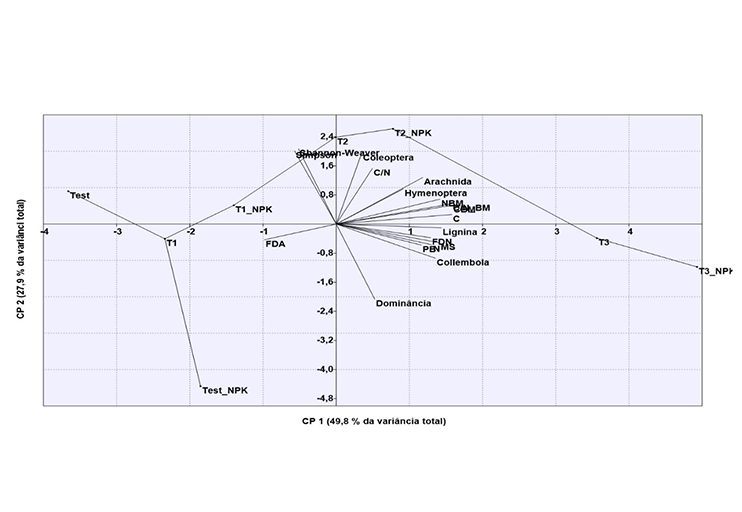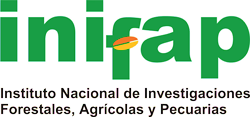Effects of doses of rice husk ash on microbial biomass and soil fauna in a natural grassland
DOI:
https://doi.org/10.29312/remexca.v16i2.3574Keywords:
agro-industrial waste, natural field, soil fauna, soil qualityAbstract
Rice husks are the residue of rice processing in industries and are generally reused in thermoelectric reactors for power generation thanks to their calorific value. This process produces rice husk ash (RHA), which can be applied alone or in combination with other raw materials in agriculture. This work aimed to verify the relationship between microbial organisms and soil fauna with soil attributes using different doses of rice husk ash. The soil was classified as Palic Haplic Luvisol, maintained under natural grassland and grazing. The experimental design consisted of randomized blocks with four treatments (T= control; T1= 5 mg; T2= 10 mg; T3= 20 mg of RHA ha-1) and four replications. Edaphic mesofauna was collected using the Provids method six months after the treatments were applied. Regarding the microbial biomass, the C and N contents of the soil were determined by dry combustion. The data were subjected to Anova (Tukey test, where p< 0.05). It was concluded that rice husk ash increases soil organic matter and microbial biomass. No differences were observed in the soil fauna with the application of ash; nonetheless, it was possible to identify trends of ecological changes with the application of these carbonized materials.
Downloads
References
Agrawal, A. and Ghosha, N. 2016. Soil microbial biomass dynamics in grassland and agroecosystem receiving varying resource quality soil inputs in dry tropics. International Journal of Agriculture, Environment and Biotechnology. 9(5):787-800. Doi.org/10.5958/2230-732X.2016.00101.7.
Anjum. and Khan, A. 2021. Decomposition of soil organic matter is modulated by soil amendments. Carbon Management. 12(1):37-50. Doi: org/10.1080/17583004.2020.1865038.
Antoniolli, Z. I.; Conceição, P. C.; Böck, V.; Port, O.; Da Silva, D. M. y Ferreira-Silva, R. 2006. Método alternativo para estudar a fauna do solo. Ciência Florestal. 16(4):407-417. Doi.org/10.5902/198050981922.
Boldrini, I. I. 1997. Campos do Rio Grande do Sul: caracterização fisionômica e problemática ocupacional. Universidade Federal do Rio Grande do Sul. https://www.ufrgs.br/floracampestre/wp-content/uploads/2020/10/Boldrini-1997pdf. 8 p.
Chauvat, M.; Perez, G. and Ponge, J. F. 2014. Foraging patterns of soil springtails are impacted by food resources. Applied Soil Ecology. 82:72-77.
Embrapa. 1997. Empresa Brasileira de Pesquisa Agropecuária. Manual de métodos de análise de solo. Centro Nacional de Pesquisa de Solos. 2da. Edición. 212 p. https://www.infoteca.cnptia.embrapa.br/infoteca/handle/doc/330804.
Embrapa. 2018. Empresa Brasileira de Pesquisa Agropecuária. Sistema brasileiro de classificação de solos 5 Ed. Brasília, Embrapa produção de informação. 436 p.
Góes, Q. R.; Barbosa, B. W.; Boligon, A. A.; Lorentz, L. H.; Vieira, F. C. B. and Weber, M. A. 2019. Suficiência amostral para avaliação da fauna epiedáfica com o método Provid. Ciência Florestal, Santa Maria. 29(1):444-450. Doi.org/10.5902/1980509831106.
Grzyb, A.; Wolna-Maruwka, A. and Niewiadomska, A. 2021. The significance of microbial transformation of nitrogen compounds in the light of integrated crop management. Agronomy, 11(7):1-27. https://doi.org/10.3390/agronomy11071415.
IBGE. 2020. Instituto Brasileiro de Geografia e Estatística. Levantamento Sistemático da Produção Agrícola. https://sidra.ibge.gov.br/tabela/1618#resultado.
Kath, A. H.; Islabão, G. O.; Vahl, L. C. and Teixeira, J. B. S. 2018. Reaction rate and residual effect of rice husk ash in soil acidity parameters. Revista Ceres, Viçosa. 65(3):278-285. Doi.org/10.1590/0034-737X201865030008.
Kuinchtner, A. and Buriol, G. A. 2001. Clima do Estado do Rio Grande do Sul segundo a classificação climática de Köppen e Thornthwaite. Disciplinarum Scientia. 2:171-182. https://periodicos.ufn.edu.br/index.php/disciplinarumNT/article/view/1136/1077.
Kushwaha, C. P. and Singh, K. P. 2005. Crop productivity and soil fertility in a tropical dryland agroecosystem: impact of residue and tillage management. Experimental Agriculture. 41:39-50. https://doi.org/10.1017/S0014479704002303.
Liu, Q.; Zhao, Y.; Li, T.; Chen, L.; Chen, Y. and Sui, P. 2023. Changes in soil microbial biomass, diversity, and activity with crop rotation in cropping systems: a global synthesis. Applied Soil Ecology. 186:1-9. Doi.org/10.1016/j.apsoil.2023.104815.
Martins Filho, M. C. F.; Hanke, D.; Nascimento, S. G. S.; Ávila, M. R. and Manriquez, D. E. T. 2020. Efeito da aplicação da cinza da casca de arroz sobre atributos de solo sob pastagem. Revista Agroecossistemas. 11(2):146-162. Doi.org/10.18542/ragros.v11i2.7483.
Mattey, P. E.; Robayo, R. A.; Díaz, J. E.; Delvasto-Arjona, S. y Monzó-Balbuena, J. M. 2014. Influencia del mezclado en dos etapas en la fabricación de ladrillos de mampostería con ceniza de cascarilla de arroz como agregado fino. Revista Colombiana de Materiales. 5:242-249.
Nguyen, T. T. and Marschner, P. 2017. Soil respiration, microbial biomass and nutrient availability in soil after addition of residue with adjusted and concentrations. Pedosphere. 27(1):76-85. Doi.org/10.1016/S1002-0160(17)60297-2.
Odum, W. E. 1988. Comparative ecology of tidal freshwater and salt marshes. Annual review of ecology and systematics. 19(1):147-176. https://www.annualreviews.org/doi/pdf/10.1146/annurev.es.19.110188.001051.
Paz-Ferreiro, J. and Fu, S. 2016. Biological indices for soil quality evaluation: perspectives and limitations. Land Degradation & Development, Brighton. 27:14-25. Doi:10.1002/ldr.2262.
Pinto, G. F.; Hanke, D.; Nascimento, S. G. S.; Ávila, M. R. y Cordeiro, J.; Fábrica, M. 2022. Efeito da cinza da casca de arroz sobre atributos de solo sob campo nativo: potencial de aproveitamento de resíduos para produção de forragem. Agroecossistema, submetido.
Tótola, M. R. and Chaer, G. M. 2002. Microorganismos e processos microbiológicos como indicadores da qualidade dos solos. Tópicos Ci. Solo. 2(2):195-276.

Published
How to Cite
Issue
Section
License
Copyright (c) 2025 Revista Mexicana de Ciencias Agrícolas

This work is licensed under a Creative Commons Attribution-NonCommercial 4.0 International License.
The authors who publish in Revista Mexicana de Ciencias Agrícolas accept the following conditions:
In accordance with copyright laws, Revista Mexicana de Ciencias Agrícolas recognizes and respects the authors’ moral right and ownership of property rights which will be transferred to the journal for dissemination in open access. Invariably, all the authors have to sign a letter of transfer of property rights and of originality of the article to Instituto Nacional de Investigaciones Forestales, Agrícolas y Pecuarias (INIFAP) [National Institute of Forestry, Agricultural and Livestock Research]. The author(s) must pay a fee for the reception of articles before proceeding to editorial review.
All the texts published by Revista Mexicana de Ciencias Agrícolas —with no exception— are distributed under a Creative Commons License Attribution-NonCommercial 4.0 International (CC BY-NC 4.0), which allows third parties to use the publication as long as the work’s authorship and its first publication in this journal are mentioned.
The author(s) can enter into independent and additional contractual agreements for the nonexclusive distribution of the version of the article published in Revista Mexicana de Ciencias Agrícolas (for example include it into an institutional repository or publish it in a book) as long as it is clearly and explicitly indicated that the work was published for the first time in Revista Mexicana de Ciencias Agrícolas.
For all the above, the authors shall send the Letter-transfer of Property Rights for the first publication duly filled in and signed by the author(s). This form must be sent as a PDF file to: revista_atm@yahoo.com.mx; cienciasagricola@inifap.gob.mx; remexca2017@gmail.
This work is licensed under a Creative Commons Attribution-Noncommercial 4.0 International license.


